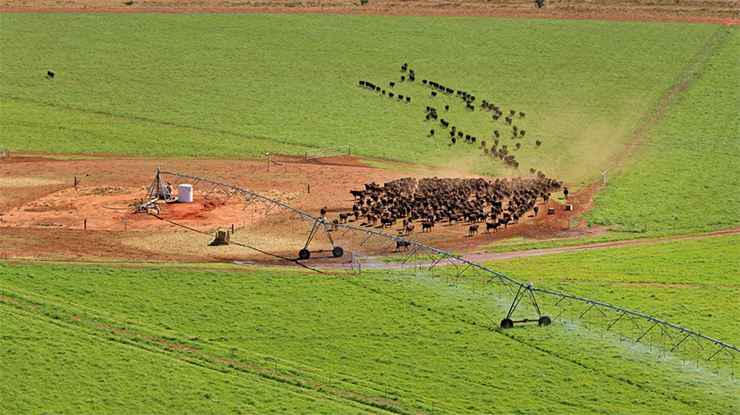Is irrigated fodder production the right fit for your business?
08 December 2021

Irrigation systems to grow high quality forage can help to overcome a key constraint with pastoral systems – the low quality of feed over the dry season, which results in stock losing condition.
There has been considerable interest in mosaic agriculture using groundwater or surface water resources in the west Kimberley and from mine de-watering in the Pilbara and in other regions across northern Australia.
The Department of Primary Industries and Regional Development (DPIRD) with co-funding from the MLA Donor Company (MDC) undertook a five-year project to identify the most viable crop and pasture options, expected production and develop management packages.
The research highlighted that before investing in irrigation, a pastoral enterprise should fully investigate the pros and cons.
Investing in on-station irrigation can give pastoralists the ability to grow high quality forage year-round and turn-off cattle to a boarder range of markets, however it can be a costly exercise and requires specialist skills.
Kevin Bell is technical innovations manager at the WA enterprise Pardoo Beef, where he has seen first-hand how irrigation development can underpin a productive beef herd.
He said that although Pardoo’s irrigation development underpins an extremely valuable Wagyu herd, there was initially scant information available on how to create a profitable irrigated system in northern WA.
“As an early-adopter in this space, we had to take a trial-and-error approach to see what worked and what didn’t,” he said.
“We had a sketchy idea of the performance of tropical grasses, based on what we knew from their use in the south-west of WA, Queensland and a little bit in the Kimberley, but not in the Pilbara or in the context of a large-scale, intensively grazed system.”
Seizing the opportunity presented by groundwater and mine dewater resources in the area, the Department of Primary Industries and Regional Development (DPIRD) and Pardoo Beef collaborated on a five-year project as part of the MDC research to evaluate a range of irrigated forages for productivity, feed quality and the economics and irrigation requirements.
Economics
DPIRD Senior research scientist Clinton Revell said there are some important steps to put in place before investing in irrigation.
“Producers developing an investment plan must ensure their production targets are realistic and explore the sensitivity of different cost and production scenarios on financial performance,” he said.
“Our economic modelling demonstrated that small-scale irrigation developments (30–50ha) can be profitable. However, investment decisions should be made carefully given the high sensitivity of income to feed quality, the sale price of steers, hay yield and the discount rate.”
“One of the more profitable scenarios is early weaning calves and feeding them in a cut-and-carry system (harvesting the crop and feeding animals off-site) with high-quality irrigated hay. This allows breeders to recover body condition earlier, thereby improving conception rates and reducing mortality rates.”
A single 40ha centre pivot irrigation enterprise in the Pilbara was estimated to cost about $1 million to become fully operational (including costs of borrowing funds) and the payback time ranged from 7–13 years, depending on cattle management.
Intensive management through high nitrogen (N) and phosphorus (P) inputs can substantially lift the productivity of Rhodes grass and improve financial returns, but variable costs are high and the system requires constant and consistent management with staff skilled in farming operations.
“Development and production costs will vary considerably according to the location, water source and scale of operation, so it is important to work through these specifically for each individual business,” Clinton said.
Water supply
DPIRD senior development officer Chris Ham said if the economics are favourable, a reliable supply of good-quality water is the cornerstone to any irrigation development.
“Reliability of supply and water quality are obviously key factors, however a range of considerations need to match up when choosing location and scale of an irrigation development.”
“These include site specific considerations such as soil type and surrounding topography, proximity to sensitive environmental assets, Aboriginal heritage and cultural assets, access and traffic ability in the wet season.”
Water quality analysis will identify potential risks to crops or soils prior to commencement of irrigation. The use of irrigation water above 180mS/m (i.e. 1000mg/L TDS) is not recommended in northern WA.
“Good irrigation management produces more uniform crops, uses fewer inputs and increases profitability through efficiency gains,” Chris said. “System capacity is a very important factor to consider when designing an irrigation system.”
Rule of thumb: System capacity
For the semi-arid tropics, DPIRD recommends a minimum constant water supply of 1.5L of water per second per hectare of irrigated land for a centre pivot system, regardless of crop type.
The water available will then determine the irrigable area. For example, a bore that produces 60L per second is capable of irrigating a maximum of 40ha. This system will have the capacity to apply up to 13mm of irrigation per hectare in 24 hours over the whole 40ha (at 100% efficiency).
Two other important considerations for beef production are matching the class of cattle with the type of feed they require and deciding whether to focus on a stand-and-graze (direct grazing) system or a cut-and-carry system. There is no ‘one size fits all’ solution and the decision depends on the specific context. Many of the larger irrigation developments use a combination of these systems, while also producing hay for on-station use and opportunistically for sale.
|
Seasonal action plan |
Find out more about growing irrigated Hard copies are available from the
|
Read more about crop selection here

 rangelands
rangelands 
